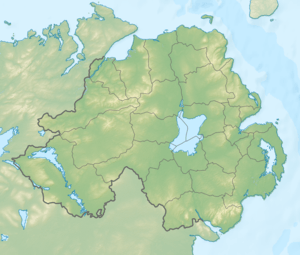1985 Newry mortar attack
| 1985 Newry mortar attack | |
|---|---|
| Part of the Troubles | |
 | |
| Location | Newry, Northern Ireland |
| Coordinates | 54°11′6.14″N 6°19′53.82″W / 54.1850389°N 6.3316167°WCoordinates: 54°11′6.14″N 6°19′53.82″W / 54.1850389°N 6.3316167°W |
| Date |
28 February 1985 18:32 (GMT) |
| Target | Royal Ulster Constabulary station |
Attack type | Mortar |
| Deaths | 9 |
Non-fatal injuries | 37 |
| Perpetrators | Provisional IRA |
On 28 February 1985, the Provisional Irish Republican Army (IRA) launched a heavy mortar attack on the Royal Ulster Constabulary (RUC) base at Corry Square in Newry, Northern Ireland. The attack killed nine RUC officers and injured almost 40 others; the highest death toll ever suffered by the RUC. Afterwards, a major building scheme was begun, to give police and military bases better protection from such attacks.
Background
In the early 1970s, after the onset of the Troubles, the Provisional IRA launched a campaign aimed at forcing the British to withdraw from Northern Ireland.
The IRA—particularly its South Armagh Brigade—had repeatedly attacked the British Army and RUC with home-made mortars, but with limited success. Between 1973 and early 1978 a total of 71 mortar attacks were recorded, but none caused direct British Army or RUC deaths.[1] There were only two deadly mortar attacks before 1985. The first was on 19 March 1979, when Private Peter Woolmore of the Queen's Regiment was killed in a mortar attack on Newtownhamilton British Army base.[2] The second was on 12 November 1983, when an RUC officer was killed and several hurt in a mortar attack on Carrickmore RUC base.[1][3]
The attack
The attack was jointly planned by members of the South Armagh Brigade and an IRA unit in Newry.[4] The homemade mortar launcher, dubbed the 'Mark 10', was bolted on to the back of a Ford lorry that had been hijacked in Crossmaglen.[1]
Shortly after 6.30PM on 28 February, nine shells were launched from the lorry, which had been parked on Monaghan Street,[5] about 250 yards (230 m) from the base.[6] At least one 50 lb shell landed on a portacabin containing a canteen, where many officers were having their evening tea break.[6] Nine police officers were killed and 37 people were hurt, including 25 civilian police employees;[5][7] the highest death toll inflicted on the RUC in its history.[8] Another shell hit the observation tower, while the rest landed inside and outside the perimeter of the base.[6]
Aftermath
The day was dubbed "Bloody Thursday" by the British press. British prime minister, Margaret Thatcher, called the attack "barbaric", while Ireland's prime minister, Garret FitzGerald, said it was "cruel and cynical", and pledged the help of the Irish security forces to catch those responsible.[7] Although not involved in the attack, Newry IRA member Eamon Collins was arrested shortly afterwards and interrogated. After five days of questioning, Collins broke under interrogation and turned supergrass, leading to more than a dozen arrests of other IRA members.[9] The attack prompted calls from unionist politicians to "increase security", and the British government launched a multi-million pound programme of construction to protect bases from similar attacks. This involved installing reinforced roofs and building blast-deflecting walls around the base of buildings.[1]
After the successful attack in Newry, the IRA carried out a further nine mortar attacks in 1985.[10] On 4 September, an RUC training centre in Enniskillen was attacked; 30 cadets narrowly escaped death due to poor intelligence-gathering by the IRA unit responsible. The cadets were expected to be in bed sleeping, but were instead eating breakfast when the bombs landed.[10][11] In November 1986, the IRA launched another attack on the RUC base in Newry, but the bombs fell short of their target and landed on residential houses. A four-year-old Catholic girl was badly wounded and another 38 people were hurt, prompting the IRA to admit that "this incident left us open to justified criticism".[10]
See also
- Downing Street mortar attack
- Osnabrück mortar attack
- Attack on Ballygawley barracks
- Chronology of Provisional Irish Republican Army actions
References
- 1 2 3 4 Urban, Mark (1993). Big Boys' Rules: SAS and the Secret Struggle Against the IRA. Faber and Faber. pp. 206–208. ISBN 0-571-16809-4.
- ↑ Malcolm Sutton. "An Index of Deaths from the Conflict in Ireland". CAIN. Retrieved 21 April 2007.
- ↑ Malcolm Sutton. "An Index of Deaths from the Conflict in Ireland". CAIN. Retrieved 21 April 2007.
- ↑ Harnden, Toby (1999). Bandit Country. Hodder & Stoughton. pp. 232–234. ISBN 0-340-71736-X.
- 1 2 McKittrick, David. Lost Lives: The Stories of the Men, Women and Children who Died as a Result of the Northern Ireland Troubles. Random House, 2001. pp.1011–1012
- 1 2 3 "I.R.A. MORTARS KILL 9 AT ULSTER BASE". The New York Times. 1 March 1985. Retrieved 28 February 2015.
- 1 2 "Northern Ireland Bloody Day". TIME. 11 March 1985. Retrieved 21 April 2007.
- ↑ "The RUC: Lauded and condemned". BBC. 31 October 2001. Retrieved 21 April 2007.
- ↑ Kevin Toolis (3 July 1999). "Death foretold". The Guardian. Retrieved 21 April 2007.
- 1 2 3 Bishop, Patrick; Mallie, Eamonn (1987). The Provisional IRA. Corgi Books. pp. 420–421. ISBN 0-552-13337-X.
- ↑ "A Chronology of the Conflict – 1985". CAIN. Retrieved 20 June 2007.